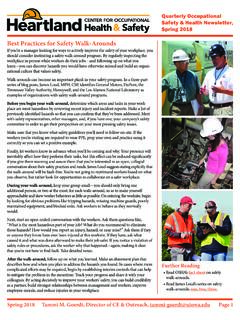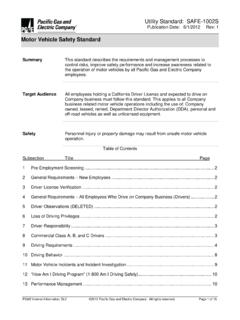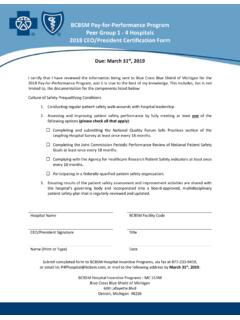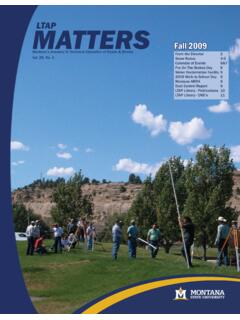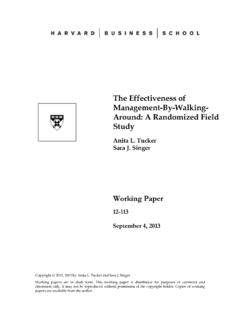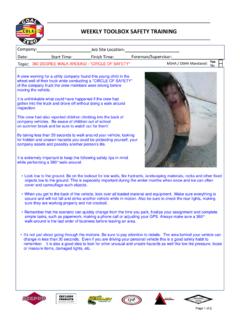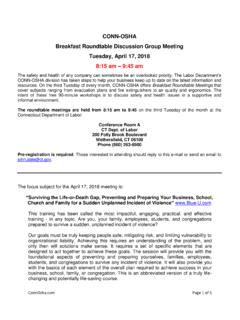Transcription of Building Accountability for Safety Leadership
1 Building Accountability for Safety LeadershipYet, for many years, Leadership as it relates to Safety has often been defined as support, which at times translates to just don t impede the process. Tradition-ally, leaders at the highest levels of an organization have fulfilled their mandate for such support by in-cluding Safety in the corporate mission statement and the operational budget. Of course, behavior-based Safety (BBS) professionals have known for quite a while that the success of our efforts hinges upon how adept we are in Building Leadership support for BBS systems.
2 However, over the years, our interest in, focus on, and definition of Leadership support has evolved .. and for good real-life experience and on-site research we have discovered that Leadership Safety support from supervisors to CEO must be actively visible to be optimally effective. As our company, Quality Safety Edge (QSE), has grown and acquired both large national and international clients, we have changed our requirements of Leadership . Why? Because the evidence reveals that doing so is absolutely necessary. For example, the data from one of our early studies, published in Professional Safety magazine, shows that when leaders perform the Safety observations/ walk arounds in their facilities and are actively engaged in those observations, they attain higher levels of par-ticipation in Safety observations from employees, a key part of a successful BBS process.
3 (McSween, 2000, see graphs below.)In facilities where leaders do 80 percent of the ob-servations they are scheduled to do, those facilities average better than 60 percent voluntary employee participation in conducting BBS observations. Our research also reveals that this type of active leader-ship involvement isn t only important during the first year of our implementation; it becomes even more im-portant for sustaining such initiatives (see the second graph below). We have replicated this correlation in a variety of other organizations. From my perspec-tive, this correlation is not so much about Leadership modeling the behavior, but rather it appears to affect a leader s credibility.
4 In other words, when the lead-ers asked their reports to participate by conducting Safety observations and feedback, the credibility of that request is higher if the employees see that the leaders make time to conduct Safety observations and is about Leadership : that s not a new Is ImportantEmployee Participation as a Function of Leadership ObservationsThis discovery was a big deal in the early stages of behavior-based Safety because in those early days many of our com-petitors were implementing behavioral observation systems that only involved employees.
5 (Some BBS consultants still take that approach.) However, with data supporting our approach, we began to routinely track Leadership participation. Today, if a company wants a behavior-based Safety process but they don t want us to work with Leadership , the bare minimum we will do is track Leadership participation in conducting obser-vation. A basic report allows us to see who is doing observa-tions and the number of total observations they ve done over any period of time ranging from one month to twelve months. With this report, we can also look at designated observers and/or supervisors, and possibly incorporate that information into the performance appraisal.
6 Typically, this re-mains the bare minimum of our intervention in working with Leadership when implementing a BBS process, and we still do some of implementations that take that approach. More typically however, we now bundle an intervention focused on leaders throughout the organization, and on getting them more engaged in promoting Safety , parallel to the implemen-tation of our behavioral Safety efforts. In other words, our projects have a duel, separate but equal focus on BBS and Safety leadershipIn his article Exploratory Analyses of the Effects of Managerial Support and Feedback Consequences on Behavioral Safety Maintenance published in the Journal of Organizational Behavior Management, Dominic Cooper makes the overall point that employees need to see leaders doing something to support Safety every week.
7 In the case of BBS, it is probably not as critical that the something is a Safety observation, but employees need to see leaders at every level engaged in ac-tivities that promote Safety ; whether they ensure that a Safety related work order gets addressed, do a a Safety observation and feedback, host a Safety meeting, or participate in a Safety committee meeting. The takeaway from his work is that we really need to focus on visible Safety was very pleased when Atul Gawande s excellent book, The Checklist Manifesto: How to Get Things Done Right was published, even though I admit I was a bit disappointed that he didn t mention behavior-based Safety .
8 In the BBS field, we have used checklists extensively for some time, including First YearLeadership Observations (43% correlation)% Employee ParticipationLeadership Observations (78% correlation)% Employee ParticipationSecond Yearthose around Leadership behaviors (sometimes as simple as a yes/no pertaining to doing a certain behavior or a frequency count). One of the things I liked about Gawan-de s book is the explanation of the many different ways to structure checklists. As I read this book, I began thinking about our approach to Safety Leadership and it occurred to me that there are other forms of checklists.
9 I have found it easier, when talking with leaders, to talk about structuring their agenda for Safety and what they re going to cover in their staff meetings, rather than talk about the Leadership checklists we have been using for the past fifteen I m talking their language! Senior managers find it more acceptable to talk about a creating a systematic review of a structured, recurring agenda at each level of the organization, rather than creating and reviewing data from Leadership checklists at each level of the organiza-tion. The way we talk about it has changed, the format of the checklists has changed, but the process creates the same, or better, level of Accountability for Leadership practices in support of , at times a Leadership checklist may be more appropriate, for example when there are a variety of kinds of behaviors, the checklist may provide a bet-ter prompt or provide better guidance, but I have had better success with structuring the agendas at differ-ent levels of the organization.
10 Additionally, agendas have some advantages over checklists. With Leadership checklist we are tracking Leadership behavior the same way we are tracking the Safety practices of employees: entering the data into computers, creating reports, and so forth. When we use a structured agenda, we can basically set that up as a paper-and-pencil effort. Give leaders a notebook with dividers for each meeting or direct report, agenda forms for each section, and they can more conveniently track their Safety activities. This approach also provides other advantages, flexibility being one of them.
